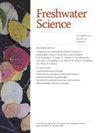Wildfire effects on mass and thermal tolerance of Hydropsyche oslari (Trichoptera) in southwestern USA montane grassland streams
IF 1.6
4区 环境科学与生态学
Q3 ECOLOGY
引用次数: 0
Abstract
Large-scale disturbances, such as wildfire, can markedly affect streams for years. As terrestrial areas within a watershed slowly recover, stream environments and biota can experience repeated and long-lasting challenges. In 2011, the Las Conchas wildfire burned 1/3 of the Valles Caldera National Preserve in northern New Mexico, USA. Seven y post-fire, streams located near the burn perimeter continue to experience varying levels of alteration (e.g., channel alteration with large diel temperature swings), whereas the terrestrial uplands have begun to recover. Extreme temperatures in stream systems may affect the aquatic community, including ectotherms such as caddisflies. These post-fire temperature ranges may increase an ectotherm’s breadth of thermal adaptation, but at metabolic costs that diminish organismal performance, such as growth, development, and fecundity. In this study we characterized in-situ effects of varied thermal regimes across preserve streams on the performance of the caddisfly Hydropsyche oslari Banks, 1905. We measured mass and critical thermal maximum (CTmax) in H. oslari larvae from preserve streams affected by wildfire (high temperature range) and in streams minimally affected by wildfire (low temperature range). We predicted that increased daily temperature maxima and reduced daily temperature minima (i.e., large diel temperature swings) would be associated with reduced H. oslari mass because of the limiting effects of suboptimal temperatures on growth. As predicted, in the weeks prior to their emergence as terrestrial adults, 5th-instar larvae within the high-temperature range stream had reduced mass (mean 3.3 ± SE 0.55 mg) relative to larvae from the low-temperature range stream (6.2 ± 0.69 mg). We also predicted that CTmax of H. oslari would reflect stream thermal history. Indeed, larvae H. oslari from the high-temperature range stream exhibited increased CTmax (35.4 ± 0.17°C) compared with larvae from the low-temperature range stream (34.4 ± 0.28°C). We demonstrated that the effects of wildfire on caddisflies can be long lasting, as evidenced by the reduced size at maturity and higher thermal tolerance in a caddisfly population 7 y post-fire.野火对美国西南部山地草原溪流水盲蝽质量和耐热性的影响
大规模的扰动,如野火,可以显著影响河流数年。随着流域内陆地区域的缓慢恢复,河流环境和生物群可能会经历反复和长期的挑战。2011年,美国新墨西哥州北部的拉斯孔查斯野火烧毁了三分之一的山谷火山口国家保护区。火灾发生七年后,位于燃烧周边附近的河流继续经历不同程度的变化(例如,河道变化伴随着较大的温度波动),而陆地高地已经开始恢复。河流系统的极端温度可能影响水生群落,包括变温动物,如热蝇。这些火灾后的温度范围可能会增加变温动物的热适应范围,但以代谢为代价,降低了生物性能,如生长、发育和繁殖力。在这项研究中,我们描述了不同的热制度在保护溪流对caddisfly Hydropsyche oslari Banks, 1905的性能的原位影响。我们测量了受野火影响的保护溪流(高温范围)和受野火影响最小的溪流(低温范围)中H. oslari幼虫的质量和临界热最大值(CTmax)。我们预测,由于次优温度对生长的限制作用,日最高温度的增加和日最低温度的减少(即较大的日温度波动)将与oslari质量的减少有关。正如预测的那样,在陆生成虫羽化前几周,高温水体中5龄幼虫的质量(平均3.3±SE 0.55 mg)比低温水体中5龄幼虫的质量(平均6.2±0.69 mg)要低。同时预测了H. oslari的CTmax能够反映河流热历史。结果表明,高温水体的CTmax(35.4±0.17℃)高于低温水体的CTmax(34.4±0.28℃)。我们证明,野火对球蝇的影响可能是持久的,正如火灾后7年球蝇种群成熟时尺寸减小和耐热性提高所证明的那样。
本文章由计算机程序翻译,如有差异,请以英文原文为准。
求助全文
约1分钟内获得全文
求助全文
来源期刊

Freshwater Science
ECOLOGY-MARINE & FRESHWATER BIOLOGY
CiteScore
4.10
自引率
0.00%
发文量
49
审稿时长
6-12 weeks
期刊介绍:
Freshwater Science (FWS) publishes articles that advance understanding and environmental stewardship of all types of inland aquatic ecosystems (lakes, rivers, streams, reservoirs, subterranean, and estuaries) and ecosystems at the interface between aquatic and terrestrial habitats (wetlands, riparian areas, and floodplains). The journal regularly features papers on a wide range of topics, including physical, chemical, and biological properties of lentic and lotic habitats; ecosystem processes; structure and dynamics of populations, communities, and ecosystems; ecology, systematics, and genetics of freshwater organisms, from bacteria to vertebrates; linkages between freshwater and other ecosystems and between freshwater ecology and other aquatic sciences; bioassessment, conservation, and restoration; environmental management; and new or novel methods for basic or applied research.
 求助内容:
求助内容: 应助结果提醒方式:
应助结果提醒方式:


